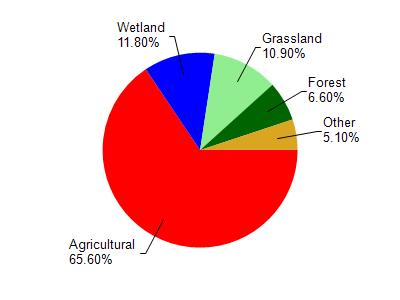Dane
No
No
No
Fish and Aquatic Life
Overview
Marshall Millpond, in the Maunesha River Watershed, is a 128.53 acre lake that falls in Dane County. This lake is managed for fishing and swimming and is currently not considered impaired.
Date 2011
Author Aquatic Biologist
Historical Description
This large, shallow impoundment of the Maunesha River is located at the Village of Marshall. Fresh meadow and shallow marsh border the lake at Its upstream end and most of the surrounding land is used for agricultural purposes. Marshall Millpond traps a large amount of sediments and nutrients from runoff from the surrounding fertile watershed. Eutrophication and turbidity are major water quality problems in the lake. Attempts to eradicate carp have proved unsuccessful. Fishing pressure is moderate. Heavy siltation turbidity, and excessive weed growth limit the lake's recreational value. A village park provides public access and a boat ramp.
Fish species: channel catfish, black crappie, white sucker, green sunfish, bullhead, largemouth bass, pumpkinseed, bluegill, northern pike, and common carp. Source: 1985, Surface Water Resources of Dane County,WI: WI-DNR Marshall Millpond - TBN, R12E Surface acres = 185, SDF = 2.57, Maximum depth = 5 ft
Date 1985
Author Surface Water Inventory Of Wisconsin
General Condition
Satellite extrapolated TSI calculations were made for this water, indicating that water quality may be "poor". Additional monitoring is advised.
TSI - Satellite, 71.0-110.0, Poor 03/13/2012 TSI = 72; Sample Count = 5; Year Count = 3; Years 2007-2011
Date 2014
Author Lisa Helmuth
Condition
Wisconsin has over 84,000 miles of streams, 15,000 lakes and milllions of acres of wetlands. Assessing the condition of this vast amount of water is challenging. The state's water monitoring program uses a media-based, cross-program approach to analyze water condition. An updated monitoring strategy (2015-2020) is now available. Compliance with Clean Water Act fishable, swimmable standards are located in the Executive Summary of Water Condition in 2018. See also the 'monitoring and projects' tab.
Reports
Recommendations
Lake Classification
Dane County Lake Classification-Phase 2: The Phase 1 classification grant classified all county lakes and streams. This grant will take the next step by developing a management program based on the classification.
Lake Classification
Dane County Department of Planning and Development will hire a project staff in order to develop a Lake Classification project, which is seen as the first step toward developing a consistent set of county-wide standards and procedures to protect Dane County Waters.
Monitor Water Quality or Sediment
Satellite extrapolated TSI calculations were made for this water, indicating that water quality may be "poor". Additional monitoring is advised.
TSI - Satellite, 71.0-110.0, Poor 03/13/2012 TSI = 72; Sample Count = 5; Year Count = 3; Years 2007-2011
Recommendations
Satellite extrapolated TSI calculations were made for this water, indicating that water quality may be "poor". Additional monitoring is advised.
Date
Author Lisa Helmuth
Management Goals
Wisconsin's Water Quality Standards provide qualitative and quantitative goals for waters that are protective of Fishable, Swimmable conditions [Learn more]. Waters that do not meet water quality standards are considered impaired and restoration actions are planned and carried out until the water is once again fishable and swimmable
Management goals can include creation or implementation of a Total Maximum Daily Load analysis, a Nine Key Element Plan, or other restoration work, education and outreach and more. If specific recommendations exist for this water, they will be displayed below online.
Monitoring
Monitoring the condition of a river, stream, or lake includes gathering physical, chemical, biological, and habitat data. Comprehensive studies often gather all these parameters in great detail, while lighter assessment events will involve sampling physical, chemical and biological data such as macroinvertebrates. Aquatic macroinvertebrates and fish communities integrate watershed or catchment condition, providing great insight into overall ecosystem health. Chemical and habitat parameters tell researchers more about human induced problems including contaminated runoff, point source dischargers, or habitat issues that foster or limit the potential of aquatic communities to thrive in a given area. Wisconsin's Water Monitoring Strategy was recenty updated.
Grants and Management Projects
Monitoring Projects
| WBIC | Official Waterbody Name | Station ID | Station Name | Earliest Fieldwork Date | Latest Fieldwork Date | View Station | View Data |
|---|
| 839100 | Marshall Millpond | 10017577 | Marshall Millpond -- Riley-Deppe County Park Boat Ramp | 12/15/2010 | 11/23/2022 | Map | Data |
| 839100 | Marshall Millpond | 10001243 | Marshall Millpond | 7/27/1999 | 9/30/2017 | Map | Data |
|

Watershed Characteristics
Marshall Millpond is located in the Maunesha River watershed which is 126.02 mi². Land use in the watershed is primarily agricultural (65.60%), wetland (11.80%) and a mix of grassland (10.90%) and other uses (11.70%). This watershed has 214.16 stream miles, 73.72 lake acres and 9,637.67 wetland acres.
Nonpoint Source Characteristics
This watershed is ranked Low for runoff impacts on streams, Low for runoff impacts on lakes and High for runoff impacts on groundwater and therefore has an overall rank of High. This value can be used in ranking the watershed or individual waterbodies for grant funding under state and county programs.However, all waters are affected by diffuse pollutant sources regardless of initial water quality. Applications for specific runoff projects under state or county grant programs may be pursued. For more information, go to surface water program grants.